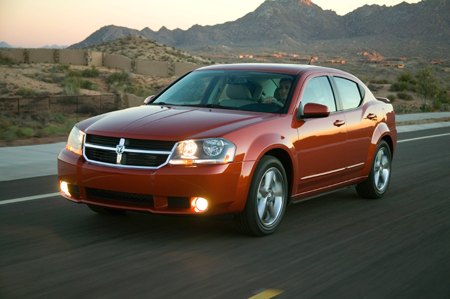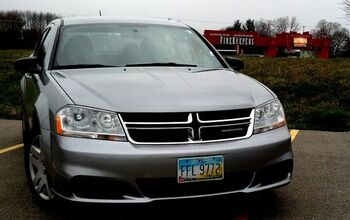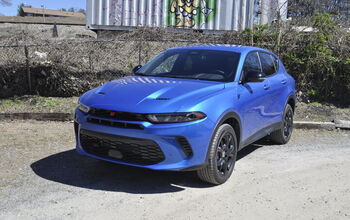Dodge Avenger Review
Riding in a golf cart to the nether regions of a dealership lot, an aging salesman explained his selling strategy. “Chryslers appeal to either male or female buyers,” he declared through nicotine-stained teeth. “Take the Compass. That’s for the ladies. The Wrangler? Boys’ toy.” As our EV reaches the 2008 Avenger, it's clear that the latest entry in The Dodge Boys' lineup is no purple Barbie Sport Convertible. But does The Avenger deliver the goods, or is “he” an impotent superhero look alike?
First, let’s be clear about from whence cometh this car: the Dodge Avenger is a reskinned Chrysler Sebring, just as the Dodge Charger is a reskinned Chrysler 300. It’s a cheap and cheerful way to give Dodge dealers something to sell that isn’t the late, unlamented Stratus, or the slow-selling Dakota, or Ye Olde Durango. Something that’ll keep the UAW’s factories humming– at least until someone else takes over.
Compared to the Sebring’s disjointed styling– afflicted as it is by a clash of Art Deco motif and Analytic Cubism — the Avenger is, um, handsome. Dodge’s crosshair grille looks far more rugged than the Sebring’s muzzle, and more elegant than the stubby, pug-faced Dodge Caliber. The Avenger’s chin spoiler and front bumper form a Charlie Sheen-like square jaw. Quad LDH optics offer the intensity and sensitivity of Leonardo DiCaprio’s eyes, while the angular windshield and clean roofline project the nobility of Johnny Depp’s brow.
While we’re beating the celebrity metaphor to a bloody pulp, the Avenger’s rear quarter panels broaden around the wheels like Fabio’s muscular shoulders and five-spoke “Ultra Bright” aluminum wheels flash like Matthew McConaughey’s pearly whites.
Two flaws mar this otherwise stunning example of automotive manhood: cheap looking triangular black inserts that fill the aft corners of the rear windows and a useless wing adorning the rear deck, an aesthetic faux pas that suits The Avenger like an ill fitted toupee on a fifty-something athlete.
Actually, I’m just being picky. The Avenger offers a distinctive design– especially compared to the boring (e.g. Honda Accord) and outright ugly (e.g. Toyota Camry) sedans that dominate the class.
A quick survey of the interior confirms the Avenger’s true identity: an automotive Himbo. It’s attractive on the outside, vacuous on the inside. The Avenger’s interior designers attempted tasteful sophistication, refraining from button overload and utilizing classic shapes. But, once again, the quality of The Chrysler’s Group’s rock hard plastics is both inexplicable and inexcusable. Even Kia uses finer materials.
The “chrome” piece that frames the gear selector is easily removed from its track. It’s a brittle piece of plastic with a chrome finish laminated to the top. This is the exact same kind of short-lived chromed plastic that GM used for the door locks in my mother’s 1969 Buick Skylark. I’d expect similar longevity from this and the rest of the dreadful Mopar parts blighting the Avenger.
On the positive side, you get a Chillzone Beverage Cooler, heated and cooled cupholders and (for the hopelessly flatulent) “odor-resistant fabric upholstery.”
My SXT tester sheltered a 2.7-liter 24-valve V6 mated to a four-speed automatic cogswapper. This so-called “powerplant” slots between the rental grade 2.4-liter 4-cylinder World Engine and the RT’s torque steer special: a 235hp 3.5-liter V6. Dodge (and my new chain smoking best friend) expects this drivetrain will be US customers’ mill of choice. The 2.7 produces 189hp and delivers 19/27 mpg (as per updated EPA standards). How great is that?
Not very. The V6 Avenger delivers neither driving excitement nor outstanding fuel economy. At pedestrian speeds, the Avenger's ride is market compliant. At anything above a parking lot pace, the Avenger lacks the chassis poise and steering feel to reward anything remotely resembling a spirited maneuver. As indicated above, the Avenger channels all its meager power through the front wheels. (Optional AWD sends some torque to the rear wheels when needed.)
Push this dreary driving street rod towards the extremes and the 17” wheels (an upgrade from the SE’s 16’s) and chassis loses its composure like a paranoid schizophrenic at a UFO convention. If you love tire-squealing understeer slides– and what ignorant enthusiast doesn’t– the Avenger is a dream come true. Unfortunately, the drum and disk binders are a bit of a nightmare. They’re initially resistant to the idea of serious stopping, and lack feel once they get with the program.
At the 2007 Dallas Auto Show, Dodge’s PR shills stood by an Avenger painted in Inferno Red Crystal Pearl and extolled the model’s many virtues. They compared it to all its rivals– except the Camry and Accord. At the risk of seeming sexist, the Avenger’s inability to compete with the class leaders must leave Chrysler hoping (against hope) there are some male buyers who believe beauty is only skin deep. Pigs.
More by William C Montgomery
Latest Car Reviews
Read moreLatest Product Reviews
Read moreRecent Comments
- HotRod Not me personally, but yes - lower prices will dramatically increase the EV's appeal.
- Slavuta "the price isn’t terrible by current EV standards, starting at $47,200"Not terrible for a new Toyota model. But for a Vietnamese no-name, this is terrible.
- Slavuta This is catch22 for me. I would take RAV4 for the powertrain alone. And I wouldn't take it for the same thing. Engines have history of issues and transmission shifts like glass. So, the advantage over hard-working 1.5 is lost.My answer is simple - CX5. This is Japan built, excellent car which has only one shortage - the trunk space.
- Slavuta "Toyota engineers have told us that they intentionally build their powertrains with longevity in mind"Engine is exactly the area where Toyota 4cyl engines had big issues even recently. There was no longevity of any kind. They didn't break, they just consumed so much oil that it was like fueling gasoline and feeding oil every time
- Wjtinfwb Very fortunate so far; the fleet ranges from 2002 to 2023, the most expensive car to maintain we have is our 2020 Acura MDX. One significant issue was taken care of under warranty, otherwise, 6 oil changes at the Acura dealer at $89.95 for full-synthetic and a new set of Michelin Defenders and 4-wheel alignment for 1300. No complaints. a '16 Subaru Crosstrek and '16 Focus ST have each required a new battery, the Ford's was covered under warranty, Subaru's was just under $200. 2 sets of tires on the Focus, 1 set on the Subie. That's it. The Focus has 80k on it and gets synthetic ever 5k at about $90, the Crosstrek is almost identical except I'll run it to 7500 since it's not turbocharged. My '02 V10 Excursion gets one oil change a year, I do it myself for about $30 bucks with Synthetic oil and Motorcraft filter from Wal-Mart for less than $40 bucks. Otherwise it asks for nothing and never has. My new Bronco is still under warranty and has no issues. The local Ford dealer sucks so I do it myself. 6 qts. of full syn, a Motorcraft cartridge filter from Amazon. Total cost about $55 bucks. Takes me 45 minutes. All in I spend about $400/yr. maintaining cars not including tires. The Excursion will likely need some front end work this year, I've set aside a thousand bucks for that. A lot less expensive than when our fleet was smaller but all German.








































Comments
Join the conversation
I've noticed that some posters have suggested a labor price/cost disadvantage experienced by the US-based automakers as a explanation for the cheapo interiors. That is proabably a bit overstated. Most of the cars sold by Toyota/Honda in North America are assembled locally. While most of transplant factories aren't UAW organized, they do pay comparable wages and benefits. The Fremont, CA NUMMI plant (which builds the Toyota Corolla, Matrix and other models) is a UAW shop. The other thing is that labor costs account for perhaps 8-9% of the total cost of a vehicle. Granted, the big difference is the legacy health care benefits and retiree benefits that GM, Chrysler and Ford have to pay given that they have an older workforce and have bought out a lot of early retirements over the years. That is a big issue. But I don't think this should be an obstacle in sourcing better plastics and designing a better interior. Heck, I think materials costs would at worst be a wash if Toyota or Honda have to source some key components from Japan, which is sensitive to the Yen/Dollar exchange rate. And petroleum based plastics affect all vehicle manufacturers.
I had the misfortune of being assigned one from the Alamo rental fleet. (Comparable model to the G6 they had on the brochure) Rubbery steering, anemic acceleration, shuddered under breaking, and non-existant rear vision. The entire rear windscreen from trunklid to roof easily fit into the rear mirror, even without the visibility-impairing aid of the trunklid spoiler. And the icing had to be the C-pillars and the SUV-hiding blind spots that they create. I nearly merged into some leadfoot on the 401 that squirted into the null visibility zone by the onramp.